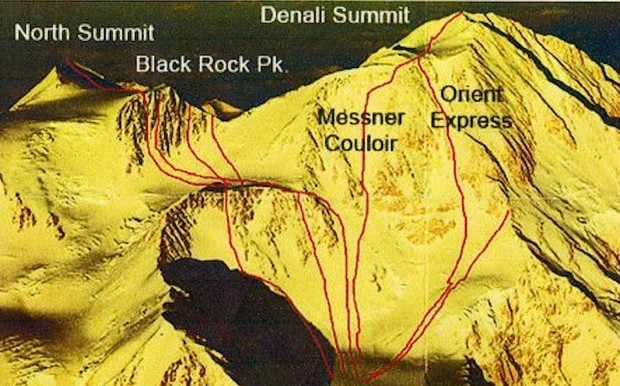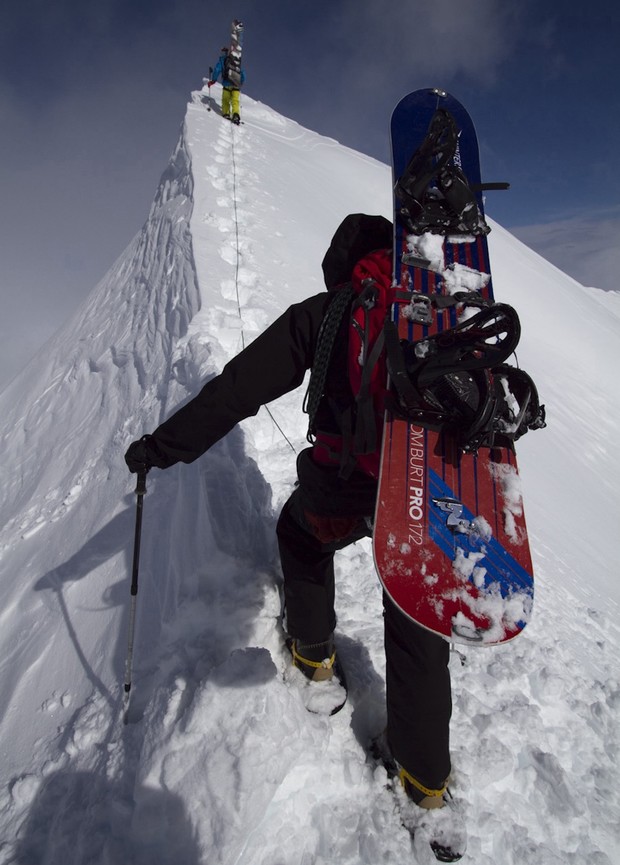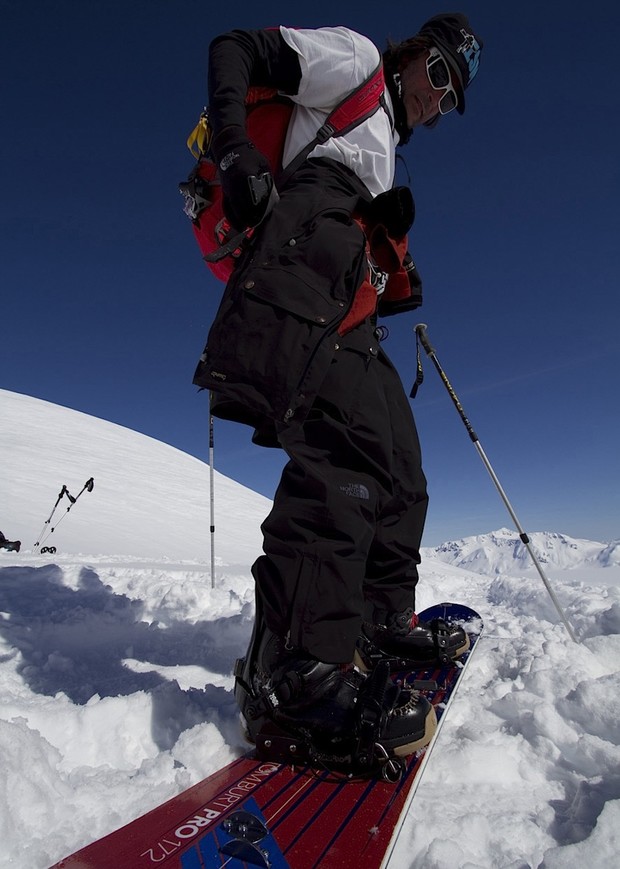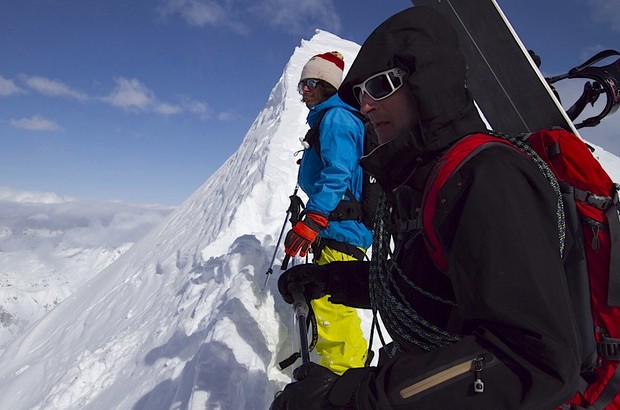tags:
Lake Tahoe |
winterstick snowboards |tom burt |tgr news |swallowtail snowboards |seth wescott |juicy fruit snowboarding commercial |jeremy jones trilogy |jeremy jones |google news |first descent in alaska |deeper |cordova peak |backcountry legends |ak deeper segment
 Tom Burt guides the Deeper crew in Alaska. Seth Lightcap photo.
Tom Burt guides the Deeper crew in Alaska. Seth Lightcap photo.
Tom Burt was riding disgustingly scary lines in Alaska when most snowboarders were dropping into hand-dug halfpipes. Widely considered the godfather of big mountain freeriding, Burt's professional snowboarding career has spanned three decades. He judges the Freeride World Tour, guides film crews, and still drops steep, technical lines.
We recently had the privilege of interviewing this influential veteran about how to ride steeps and the progression of big mountain snowboarding. Here is what Tom Burt has to say.
How did you start riding big lines in Alaska? Can you describe the moment you first thought, 'I have to do this kind of riding no matter what'?
My first experience in AK came about because Jim Zellers and I made a bucket list of mountains and places we wanted to go snowboard. Denali was high on that list and we slated it in 1989, but got talked into going to the Ruth Glacier for a month's snowboarding trip instead.
This was my first experience hiking and riding Alaskan steeps. I was hooked. The steeps were big, long, and sustained. So in 1991, Jim and I went back for our second trip to AK, this time to ride the Orient Express off Denali.
 Lines of Denali from WildSnow.com. Bradford Washburn photo.
Lines of Denali from WildSnow.com. Bradford Washburn photo.
1992 was the first year that I helicopter skied in AK. We were in the Valdez area. There were no guides. Just a lift to anywhere you wanted to go–unridden mountains, and lines in all directions. I spent over a month there heli-ing, riding new terrain, camping and hiking lines, and in that time, judged the first World Snowboard Extremes.
You were a math teacher. Why did you choose that career path? Is there something about that type of intelligence that's translates into your snowboarding? Into your board design?
In college, I started in engineering but did not like it, so I switched to teaching which I enjoyed very much. I had just become a professional snowboarder in 1985, and I was snowboarding and finishing college through the 85-86 season.
During the 86/87 season I was teaching high school math and trying to snowboard in my spare time, which was limited. So I thought I would try to be a full-time professional snowboarder in 1987-88 and see if I could pull off the winter riding and not working. It worked thanks to the Juicy Fruit commercial.
I figured I would go back to teaching in a year or two. I was already old for snowboarding at 24. I thought this would last maybe 3 years and then new young pro riders would take over. Well, I was wrong, and I have been a pro-rider for 30 years.
As far as intelligence, I suppose I have used it to design and shape my boards for how I like to ride. I am very analytical of how things work and want them to work well and I want to know why.
 Burt's Winterstick pro model is one of the longest running in snowboarding. Seth Lightcap photo.
Burt's Winterstick pro model is one of the longest running in snowboarding. Seth Lightcap photo.
What are your goals in working Winterstick Snowboards? Can you discuss your design philosophy with that company, and with your pro model?
My goals are to make boards that work well and that I can have fun riding the way I like to ride. And hopefully others will like them also. The design philosophy at Winterstick since I started working with them has been and still is to make directional boards to ride the whole mountain top to bottom.
Boards like the swallowtail are classic powder or soft snow condition boards. They have extra wide noses with a long drawn out rocker that gives the boards incredible lift. This allows you to lean forward while making a turn and drive the board through it.
The deep swallow on the other hand allows you to sink the tail with very little shifting of your weight and allows the board to fully engage the sidecut and turn extremely easily. You can make long, draw- out turns, feeling like you are driving a Cadillac. Then you can shift your weight a little back, and all of the sudden, you are ripping tight turns like a Porsche.
I would say the swallowtail is the most enjoyable powder riding board I have been on ever. If you ride it on hard pack, it rides okay. The width hinders you edging. The swallowtail can get hung up in turns, and it is not the tool for the job.
My board the TB172 I designed to ride powder with a long nose, taper which shifts the center of the board backwards, and stance shifted back off the center of the sidecut. At the same time the board is designed to ride on steep variable terrain in all conditions. It is designed to be better at speed with a stiff progressive flex, a straight sidecut, and full ABS sidewalls for dampening.
The faster you go on my board the better it feels. The drawbacks come when you are going slower because you have to put a lot of energy into the board to make it turn and in riding switch because the board is truly directional so the flex, and taper are fighting you. But every design can not cover it all.
The trick is to design boards that work well for a certain type of riding. It is like surfing, a big wave board is for big waves. You can surf it waist-high surf, but it won't be very much fun. Winterstick uses this philosophy to design boards for freeriding mountains.
You've judged the Freeride World Tour and The North Face Masters. What role do you think competitive freeriding plays in snowboarding right now?
Judging mountain competitions is interesting because it is a fixed mountain, but the athletes choose their line and create the energy to make it come to life.
The role competition has is a venue for riders to try to make a living as a professional that is not in the freestyle, pipe, or boardercross. You do not have to have big sponsors to do well. Yes, filming is another way of marketing, but it is a very elite group usually held in the videos by sponsors paying for the athletes to be there.
Almost all the riders who are in the videos were former competitors in some way. That is how they made their start and then moved into filming. Even myself.
You've had many first descents, and ridden many, many terrifyingly steep lines. How do you decide what you want to ride?
When I started to snowboard, I wanted to snowboard all the terrain that I could ski. Skiing was my first passion on the snow. It took years of practice riding lines, doing airs and learning how to use my snowboard to surpass my skiing, but then I realized a snowboard is a better tool in the steeps. It allowed me to do things that were not possible on my skis at the time. So I just kept pushing my limits to see where I could ride, be in control and have fun.
It took years of practice riding lines, doing airs and learning how to use my snowboard to surpass my skiing, but then I realized a snowboard is a better tool in the steeps. It allowed me to do things that were not possible on my skis at the time.
So I just kept pushing my limits to see where I could ride, be in control and have fun. That led me to terrain that had not be ridden. I always choose the lines that captured my eye. When I look at a mountain there is usually one line that just sticks out to me. My vision. You may look at it and see something completely different and that is okay. That is your vision.
That led me to terrain that had not be ridden. I always choose the lines that captured my eye. When I look at a mountain there is usually one line that just sticks out to me. My vision. You may look at it and see something completely different and that is okay. That is your vision. Being scared is part of riding but being scared is the energy I tap into to ride challenging lines.
 Burt getting ready to drop as he guides the Deeper crew. Seth Lightcap photo.
Burt getting ready to drop as he guides the Deeper crew. Seth Lightcap photo.
How do you prepare and execute riding 55-plus-degree lines and cope with oh-shit moments?
The prep comes from all the practice I do when I normally ride. So when I am ready to drop I know that my body and mind are there together. My personal routine is to count myself in because of all the filming I have done. It just seems normal for me to say '3, 2, 1, Drop.'
As far as Oh-Shit moments, my brain will slow down the situation in my mind so I can look at it, analyze what I need to do, and then just do it. The more intense the moment the slower time goes in my brain. It is like I create time to make decisions.
Can you offer any tips to the audience about how to ride steeps?
The biggest thing for steeps is that you have to lean forward to ride steeps. The steeper it gets, the more forward (toward your nose) you have to be. You can not ride your back leg.
Practice riding. Put the time into learning great technique on all terrain, conditions. When the snow is perfect, anyone can ride. But to ride steep lines you need to be able to ride steep, icy crap and be comfortable on it. There is only one way to do that: go out and ride all the time, no matter the conditions. Progression comes from practicing. I still to this day practice my riding all the time so when I ride a difficult line I can do it and not die trying.
What were the top five best lines you've ridden in your life and why?
Hard saying. way too many great lines in different places to pick five. Riding lines is fun for me so five is trivial to the thousands in my brain. You have to understand that I love to snowboard, and there are so many great places to make turns. I am partial to the Sierra Nevada Range because they are home for me, but that does not mean I don't like other mountains just as much.
Each range, mountain, or run is unique and they all have their positives and negatives, which makes them what they are. My favorite run was, is and will always be my last powder turn.
What I look for in a run is terrain that fits my style of riding. Of course, that has changed over my whole time snowboarding and it continues to morph even today.
I generally look for features and lines that are aesthetic to my eye and that I can have fun with while I am riding. Now my idea of fun maybe on a different level than yours, and I would suggest riding lines and features that fit your vision not someone else's.
 Scoping lines with Jeremy Jones (upper left). Seth Lightcap photo.
Scoping lines with Jeremy Jones (upper left). Seth Lightcap photo.
From where you've started to now, how do you think big mountain snowboarding has progressed as a whole? How have your skills progressed during this time?
When I started, there was very little big mountain riding done on a board. So it has progressed from trying to find out what was possible and going out and doing it.
My skills progressed from a skier who love to ski, hike, do big airs, and go fast to a snowboarder who wanted to do the same. Then my skills went beyond my skiing and into the unknown of what I could do.
I also took an active roll to learn about the snow and avalanches so I could make good decisions in the mountains. Riding lines on big mountains takes more than just doing it. You have to respect them, learn about them, and move through them with knowledge that you are a very small thing who is powerless against the will of the mountain. I have been lucky and found a path the mountains have let me take. It takes lots of work to continue, but I love the job.






